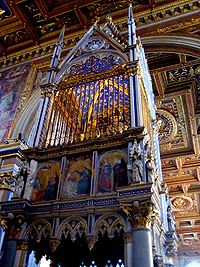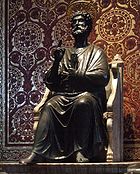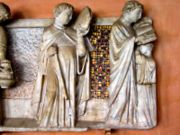
Arnolfo di Cambio
Encyclopedia


Italy
Italy , officially the Italian Republic languages]] under the European Charter for Regional or Minority Languages. In each of these, Italy's official name is as follows:;;;;;;;;), is a unitary parliamentary republic in South-Central Europe. To the north it borders France, Switzerland, Austria and...
architect
Architect
An architect is a person trained in the planning, design and oversight of the construction of buildings. To practice architecture means to offer or render services in connection with the design and construction of a building, or group of buildings and the space within the site surrounding the...
and sculptor
Sculpture
Sculpture is three-dimensional artwork created by shaping or combining hard materials—typically stone such as marble—or metal, glass, or wood. Softer materials can also be used, such as clay, textiles, plastics, polymers and softer metals...
.
Biography
Arnolfo was born in Colle Val d'Elsa, TuscanyTuscany
Tuscany is a region in Italy. It has an area of about 23,000 square kilometres and a population of about 3.75 million inhabitants. The regional capital is Florence ....
.

Nicola Pisano
Nicola Pisano was an Italian sculptor whose work is noted for its classical Roman sculptural style. Pisano is sometimes considered to be the founder of modern sculpture.- Early life :His birth date or origins are uncertain...
’s chief assistant on the marble pulpit
Pulpit (Siena Cathedral)
The pulpit of the Siena Cathedral was sculpted between the end of 1265 and November 1268 by Nicola Pisano with the extensive participation of his son Giovanni Pisano and his assistants Arnolfo di Cambio, Lapo di Ricevuto and several other artists...
for the Duomo in Siena
Siena
Siena is a city in Tuscany, Italy. It is the capital of the province of Siena.The historic centre of Siena has been declared by UNESCO a World Heritage Site. It is one of the nation's most visited tourist attractions, with over 163,000 international arrivals in 2008...
(1265–1268), but he soon began to work independently on an important tomb sculpture. In 1266-1267 he worked in Rome
Rome
Rome is the capital of Italy and the country's largest and most populated city and comune, with over 2.7 million residents in . The city is located in the central-western portion of the Italian Peninsula, on the Tiber River within the Lazio region of Italy.Rome's history spans two and a half...
for King Charles I of Anjou, portraying him in the famous statue housed in the Campidoglio. Around 1282 he finished the monument to Cardinal Guillaume de Braye in the church of San Domenico in Orvieto, including an enthroned Madonna (a Maestà
Maestà
Maestà, the Italian word for "majesty", designates an iconic formula of the enthroned Madonna with the child Jesus, whether or not accompanied with angels and saints...
) for which he took as a model an ancient Roman statue of the goddess Abundantia
Abundantia
In ancient Roman religion, Abundantia was a divine personification of abundance and prosperity. She was among the embodiments of virtues in religious propaganda that cast the emperor as the ensurer of "Golden Age" conditions. Abundantia thus figures in art, cult, and literature, but has little...
; the Madonna's tiara
Tiara
A tiara is a form of crown. There are two possible types of crown that this word can refer to.Traditionally, the word "tiara" refers to a high crown, often with the shape of a cylinder narrowed at its top, made of fabric or leather, and richly ornamented. It was used by the kings and emperors of...
and jewels reproduce antique models. In Rome Arnolfo had seen the Cosmatesque
Cosmatesque
Cosmatesque, or Cosmati, is a style of geometric decorative inlay stonework typical of Medieval Italy, and especially of Rome and its surroundings. It was used most extensively for the decoration of church floors, but was also used to decorate church walls, pulpits, and bishop's thrones...
art, and its influence can be seen in the intarsia
Intarsia
Intarsia is a form of wood inlaying that is similar to marquetry. The term is also used for a similar technique used with small, highly polished stones set in a marble matrix .- History :...
and polychrome glass decorations in the churches of San Paolo fuori le Mura and Santa Cecilia in Trastevere
Santa Cecilia in Trastevere
Santa Cecilia in Trastevere is a 5th century church in Rome, Italy, devoted to Saint Cecilia, in the Trastevere rione.-History:The first church on this site was founded probably in the 3rd century, by Pope Urban I; it was devoted to the Roman martyr Cecilia, martyred it is said under Marcus...
, where he worked in 1285 and 1293 respectively. In this period he also worked on the presepio of Santa Maria Maggiore, on Santa Maria in Aracoeli
Santa Maria in Aracoeli
The Basilica of St. Mary of the Altar of Heaven is a titular basilica in Rome, located on the highest summit of the Campidoglio. It is still the designated Church of the city council of Rome, which uses the ancient title of Senatus Populusque Romanus...
, on the monument of Pope Boniface VIII
Pope Boniface VIII
Pope Boniface VIII , born Benedetto Gaetani, was Pope of the Catholic Church from 1294 to 1303. Today, Boniface VIII is probably best remembered for his feuds with Dante, who placed him in the Eighth circle of Hell in his Divina Commedia, among the Simonists.- Biography :Gaetani was born in 1235 in...
(1300) and on the bronze statue of St. Peter in St. Peter's Basilica
St. Peter's Basilica
The Papal Basilica of Saint Peter , officially known in Italian as ' and commonly known as Saint Peter's Basilica, is a Late Renaissance church located within the Vatican City. Saint Peter's Basilica has the largest interior of any Christian church in the world...
.
In 1294-1295 he worked in Florence, mainly as an architect. According to his biographer Giorgio Vasari
Giorgio Vasari
Giorgio Vasari was an Italian painter, writer, historian, and architect, who is famous today for his biographies of Italian artists, considered the ideological foundation of art-historical writing.-Biography:...
, he was in charge of construction of the cathedral
Santa Maria del Fiore
The Basilica di Santa Maria del Fiore is the cathedral church of Florence, Italy. The Duomo, as it is ordinarily called, was begun in 1296 in the Gothic style to the design of Arnolfo di Cambio and completed structurally in 1436 with the dome engineered by Filippo Brunelleschi...
of the city, for which he provided the statues once decorating the lower part of the façade destroyed in 1589. The surviving statues are now in the Museum of the Cathedral. Also attributed to Arnolfo is the design of the Church of Santa Croce
Basilica di Santa Croce di Firenze
The Basilica di Santa Croce is the principal Franciscan church in Florence, Italy, and a minor basilica of the Roman Catholic Church. It is situated on the Piazza di Santa Croce, about 800 metres south east of the Duomo. The site, when first chosen, was in marshland outside the city walls...
. Vasari also attributed to him the urban plan of the new city of San Giovanni Valdarno
San Giovanni Valdarno
San Giovanni Valdarno is a town and comune in the province of Arezzo, Tuscany, central Italy, located in the valley of the Arno River. It was originally called Castel S. Giovanni....
.
The monumental character of Arnolfo's work has left its mark on the appearance of Florence. His funerary monuments became the model for Gothic funerary art
Funerary art
Funerary art is any work of art forming, or placed in, a repository for the remains of the dead. Tomb is a general term for the repository, while grave goods are objects—other than the primary human remains—which have been placed inside...
.
Giorgio Vasari included a biography of Arnolfo in his Lives of the Artists.
Architecture
- Old basilica of Santa Maria del FioreSanta Maria del FioreThe Basilica di Santa Maria del Fiore is the cathedral church of Florence, Italy. The Duomo, as it is ordinarily called, was begun in 1296 in the Gothic style to the design of Arnolfo di Cambio and completed structurally in 1436 with the dome engineered by Filippo Brunelleschi...
, FlorenceFlorenceFlorence is the capital city of the Italian region of Tuscany and of the province of Florence. It is the most populous city in Tuscany, with approximately 370,000 inhabitants, expanding to over 1.5 million in the metropolitan area....

Sculpture
- St. Peter Enthroned inside St. Peter's BasilicaSt. Peter's BasilicaThe Papal Basilica of Saint Peter , officially known in Italian as ' and commonly known as Saint Peter's Basilica, is a Late Renaissance church located within the Vatican City. Saint Peter's Basilica has the largest interior of any Christian church in the world...
, is often attributed to Arnolfo. - Monument to Pope Adrian VPope Adrian VPope Adrian V , born Ottobuono de' Fieschi, was pope in 1276.-Biography:Ottobuono belonged to a feudal family of Liguria, the Fieschi, Counts of Lavagna....
(1276, attributed) - San Francesco, ViterboViterboSee also Viterbo, Texas and Viterbo UniversityViterbo is an ancient city and comune in the Lazio region of central Italy, the capital of the province of Viterbo. It is approximately 80 driving / 80 walking kilometers north of GRA on the Via Cassia, and it is surrounded by the Monti Cimini and... - Monument to Riccardo Cardinal Annibaldi (1276) - San Giovanni in Laterano, RomeRomeRome is the capital of Italy and the country's largest and most populated city and comune, with over 2.7 million residents in . The city is located in the central-western portion of the Italian Peninsula, on the Tiber River within the Lazio region of Italy.Rome's history spans two and a half...
- Statue of Charles I of Anjou (1277) - Campidoglio, RomeRomeRome is the capital of Italy and the country's largest and most populated city and comune, with over 2.7 million residents in . The city is located in the central-western portion of the Italian Peninsula, on the Tiber River within the Lazio region of Italy.Rome's history spans two and a half...
- Fountain of the Thirsty People (Fontana Minore) - Perugia
- Tomb of Cardinal Guillaume de Braye (c. 1282) - San Domenico, OrvietoOrvietoOrvieto is a city and comune in Province of Terni, southwestern Umbria, Italy situated on the flat summit of a large butte of volcanic tuff...
- Monument of Pope Boniface VIII - the Museo dell'Opera del DuomoMuseo dell'Opera del Duomo (Florence)The Museo dell'Opera del Duomo in Florence, Italy is a museum containing many of the original works of art created for the Basilica di Santa Maria del Fiore, the cathedral of Florence. The museum is located just east of the Duomo, near its apse...
- Florence

